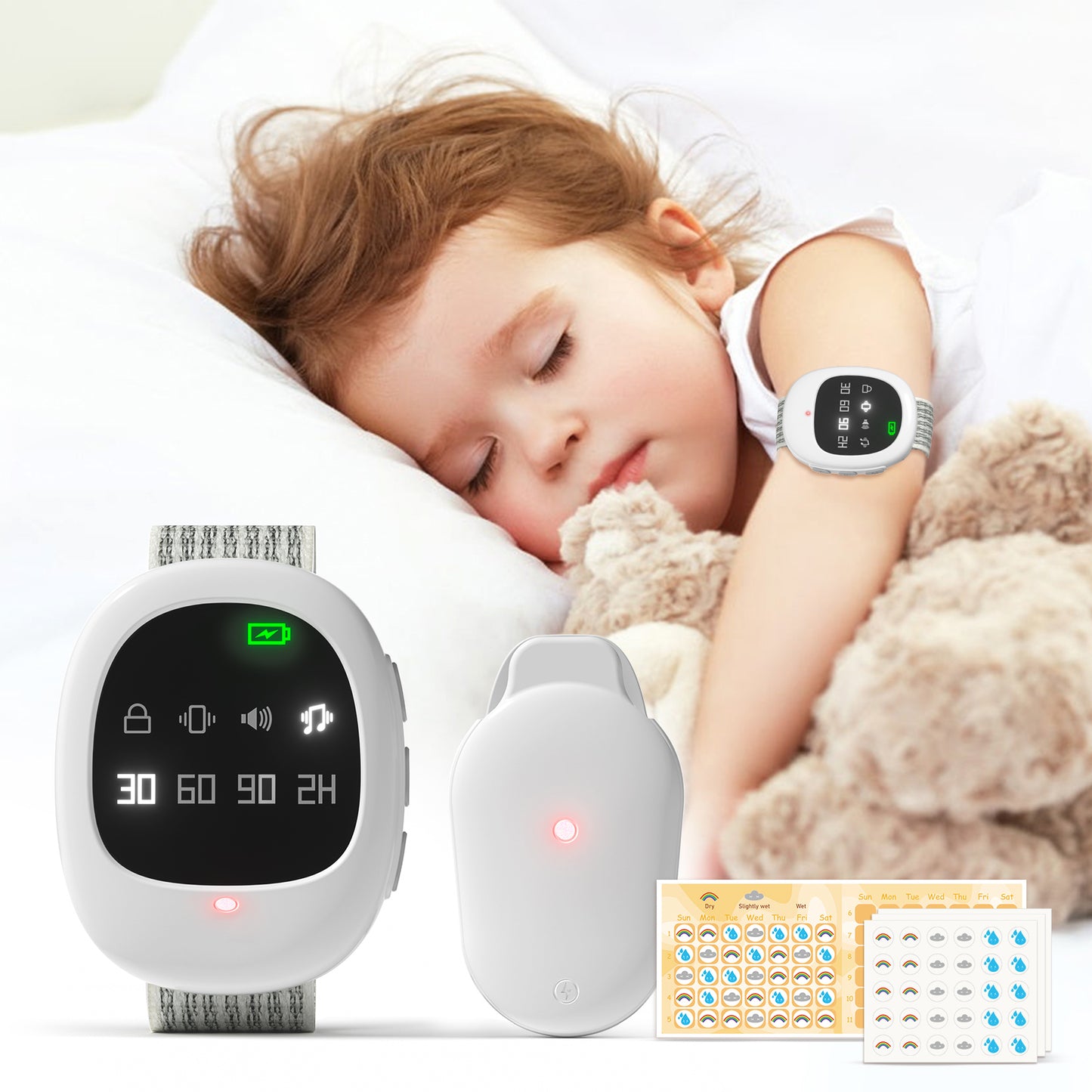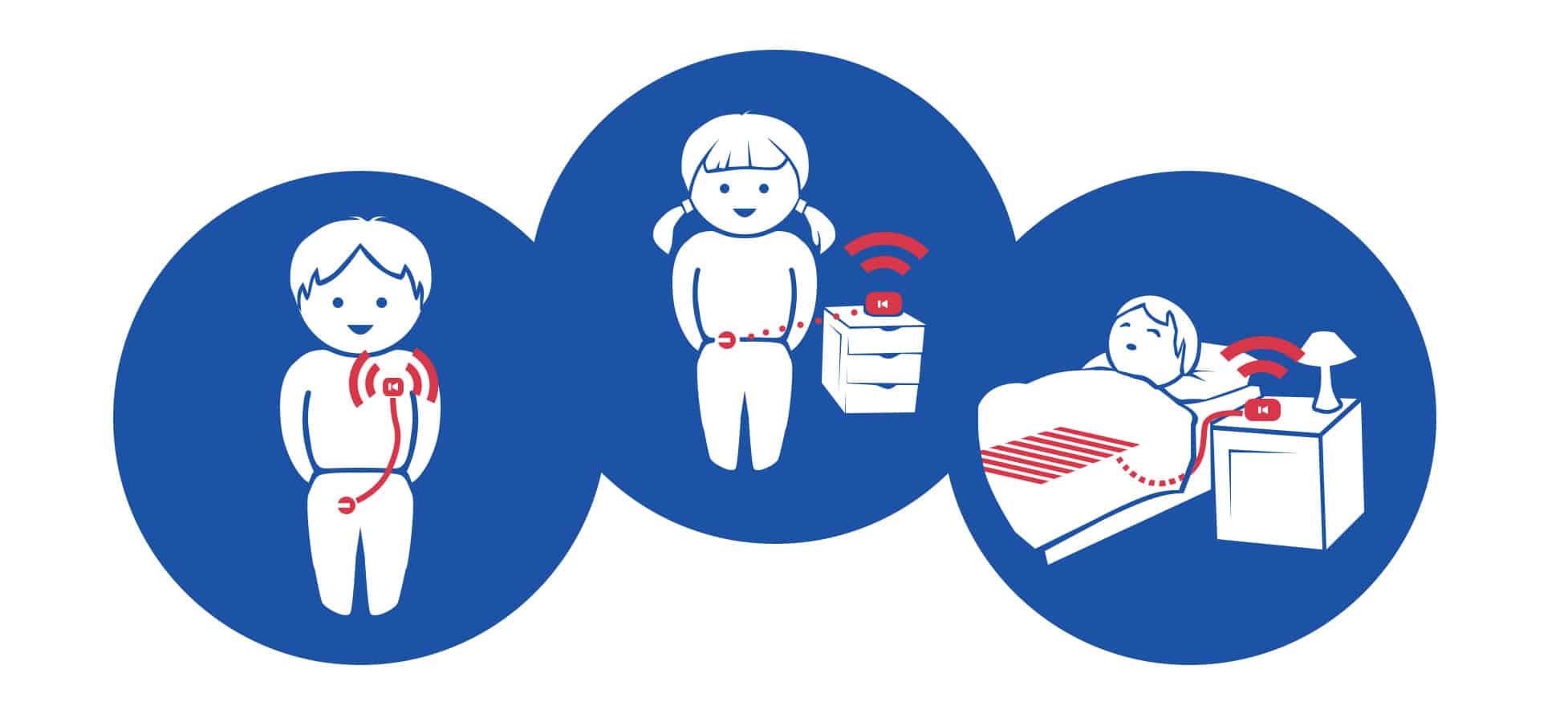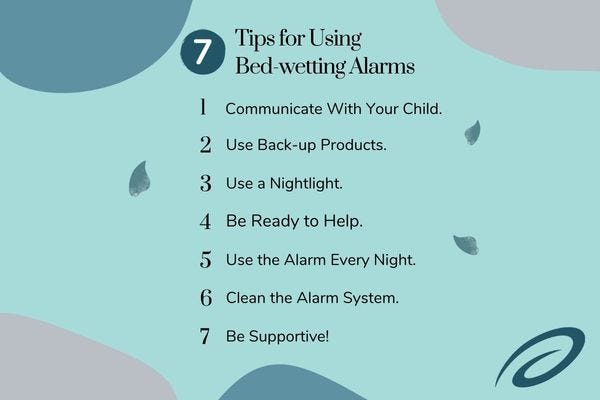
Key Takeaways:
- Wireless bed wetting alarms are an invaluable tool for managing nocturnal enuresis in children, tweens, and teens.
- 75% of parents say their kids stopped wetting within a few months.
- Choose an alarm with these 6 features. Wireless for comfort. Instant urine detection. Child must get up to reset alarm. Custom tone, volume, vibration, and intensity. Online app for easy tracking. And easy to clean.
- Scroll down for Amazon’s top 3 wireless alarms: product details, pros-and-cons, reviews and prices.
- Get fast and easy cleanup when you combine the alarm with a waterproof mattress protector for bed wetting.
Role of Wireless Bed Wetting Alarms

Wireless bed wetting alarms are a game-changer. They can detect a single drop of moisture and sound an alarm, helping your child wake up and use the bathroom. Over time, they recognize the need to urinate and wake up naturally.
How Do Wireless Bed Wetting Alarms Work?

Wireless alarms work by placing a sensor in the bed, or in specially designed underwear, that communicates with an alarm unit. It’s best to keep the alarm unit in the child’s room so when they get up to use the bathroom, they can reset the alarm by themselves. In this way they’re taking charge and becoming an active participant in the solution.
Choosing the Right Wireless Bed Wetting Alarm
Some of the key features to consider when choosing a wireless alarm include:
- Wireless for comfort: The sensor should be comfortable and unobtrusive to ensure your child can sleep soundly.
- Instant urine detection: The alarm should be sensitive enough to detect moisture quickly but not so sensitive that it gives false alarms.
- Manual alarm reset: The child must get up to use the toilet and reset the alarm. In this way they are training their brain to control their bladder.
- Volume and Vibration: The alarm should be loud enough to wake your child. Often a vibration feature works better for deep sleepers.
- Online app: An online app makes it easy for parents to track at night from another room, and it makes it easy for kids to see their progress.
- Easy to Clean: It should be easy to clean and maintain for maximum hygiene.
In addition, it’s good to look for a guarantee or product warranty on the label. And check out some online user reviews to see what other parents think about the product.
Amazon’s Top 3 Wireless Alarms for Bed Wetting
1. DryEasy

- Product Name: DryEasy Wireless Bedwetting Alarm
Reviews: Number one best seller on Amazon with a 4.3-Star Rating (5,600+ reviews).
Volume Control: 4-level volume control caters to different needs.
- Selectable Sounds: 6 selectable sounds to suit users’ preference and avoid users from getting used to a particular sound.
- Random Playing: Some users stop responding to the alarm due to inertia. The random playing feature helps to avoid this phenomenon.
- Different Operation Modes: Sound only, vibration only, and sound plus vibration.
- Detachable Cable: Replacement cable can be bought separately, without having to buy a new unit.
- Amazon Price: $39.99
2. Malem Ultimate 1

- Product Name: Malem Ultimate 1 Wireless Bedwetting Alarm
Reviews: Top seller on Amazon with a 4.0-Star Rating (1,500+ reviews).
- Award Winning: Recommended by doctors and pediatricians for 30 years for the treatment of bed wetting.
- Compact, Comfortable, Lightweight: Combines sound, vibration and light to wake even the deepest sleeper wake. Tamper proof selection switch can be set to sound only, vibration only, or sound and vibration. 20 different alarm settings with a flashing light with a 2-step turnoff mechanism.
- Advanced Easy-Clip Sensor Technology: Secure Grip stays put all night and alerts user when it’s not fastened correctly. Quick Detect senses the first drop of moisture.
- Free Smartphone App: Access tips for parents, online tracking tools, FAQs, and videos to ensure success.
- Amazon Price: $109.95
3. DryBuddy

- Product Name: DryBuddy FLEX 3 Wireless Bedwetting Alarm
Reviews: Outstanding seller on Amazon with a 4.2-Star Rating (50+ reviews).
- Convenience: 3rd generation system offers 200 feet (61 meters) wireless performance. Loudest sound and music settings and strongest vibrations available on the market, plus optional bed shaker. Perfect for deep sleepers, sensitive children, and special needs children. Won’t be triggered by perspiration.
- Easy & Simple: One button operation or use remote for silent monitoring and controlling from a distance.
- Certifications: FDA, FCC, CE, RoHS registered and certified.
- Warranty: One-year limited warranty.
- Amazon Price: $164.99
Tips & Strategies for Parents

Maximizing the Benefits of the Alarm’s Features
To ensure the alarm is as effective as possible, familiarize yourself with its features. For example, if the alarm has volume control, adjust it to a level that will wake your child without causing distress. If it includes a vibration feature, place the unit close to where your child will feel it. Encourage your child to take responsibility for resetting the alarm after it goes off, as this can help them become more attuned to their body’s signals during the night.
When to Expect Results
It’s natural to hope for immediate results, but it’s important to set realistic expectations. Typically, it can take several weeks to months for a child to respond to a bed wetting alarm. Consistency is key. The alarm should be used every night. And remember that every child is unique so progress can vary. Celebrate small victories, such as a decrease in the number and frequency of wet nights, because these are signs that the alarm is working.
Tracking Progress and Adjusting Use
Keep a log of bed wetting incidents to track progress. This can help you identify patterns and make necessary adjustments. If you notice that your child is starting to wake up on their own before the alarm sounds, it’s a good sign that they are developing the necessary nighttime bladder control. As they improve, you can gradually phase out the use of the alarm.
Frequently Asked Questions (FAQ)
1. How do wireless bed wetting alarms work?
Wireless bed wetting alarms consist of a moisture sensor and an alarm unit. The sensor is placed in the child’s bed and detects any signs of moisture. When wetness is detected, the sensor sends a signal to the alarm unit, which then emits a sound or vibration to wake the child. Over time, this helps the child learn to recognize the feeling of a full bladder and wake up before wetting the bed.
2. Are wireless bed wetting alarms safe for kids, tweens, and teens?
Absolutely. Wireless bed wetting alarms are designed with safety in mind. They use low-voltage batteries and are made with materials that are safe for children. However, it’s important to follow the manufacturer’s instructions for use and to supervise young children when they are setting up or maintaining the alarm.
3. How long should my child use a bed wetting alarm?
Using a bed wetting alarm is not an overnight solution; it’s a process that involves learning and habit formation. Typically, a child might need to use the alarm for about two to three months, but this can vary. Some children may need less time, while others might need longer before they start waking up dry consistently. It’s crucial to continue using the alarm until your child has achieved a significant number of consecutive dry nights, usually around 14 to 21 in a row.
4. Can wireless bed wetting alarms completely stop bed wetting?
Wireless bed wetting alarms have a high success rate, with many children eventually stopping bed wetting entirely. Some children may stop after a few months of using the alarm. Others may see a gradual improvement over time. The key is to use the alarm consistently and to combine its use with other supportive measures. It’s also essential to celebrate your child’s progress, no matter how small, as this can boost their confidence and encourage them to keep going.
5. What do I do if the alarm is making it hard for my child to get to sleep?
If the alarm is causing sleep disturbances for your child try adjusting the alarm settings. Many alarms come with volume control and different tones or vibrations. Find a setting that is effective in waking your child but not too startling or disruptive.
Another strategy is to incorporate the alarm into your child’s bedtime routine gradually. Start by having the alarm in the room without setting it for the first few nights, allowing your child to get used to its presence. Over time, as your child becomes more comfortable with the alarm, it should become less of an obstacle to falling asleep.
Sources
- American Academy of Pediatrics. (2014). Bedwetting (Nocturnal Enuresis) in Children. HealthyChildren.org. https://www.healthychildren.org/English/health-issues/conditions/genitourinary-tract/Pages/Bedwetting-Nocturnal-Enuresis.aspx
- Jansson, U.-B., Hanson, M., Sillén, U., Hellström, A.-L. (2005). Voiding Pattern and Acquisition of Bladder Control from Birth to Age 6 Years—A Longitudinal Study. The Journal of Urology, 174(1), 289–293. https://doi.org/10.1097/01.ju.0000161614.40884.67
- American Urological Association. (2022). Nocturnal Enuresis (Bedwetting) in Children. Urology Care Foundation. https://www.urologyhealth.org/urology-a-z/n/nocturnal-enuresis-(bedwetting)-in-children
- Cooper, J., Lendvay, T., Dave, S. (2018). Evaluation and Management of Enuresis. American Family Physician, 97(12), 785–793. https://www.aafp.org/afp/2018/0615/p785.html
- Caldwell, P. H., Nankivell, G., Sureshkumar, P. (2013). Simple behavioural interventions for nocturnal enuresis in children. Cochrane Database of Systematic Reviews, 7(7), CD003637. https://doi.org/10.1002/14651858.CD003637.pub3
- Yeung, C. K., Sreedhar, B., Sihoe, J. D., Sit, F. (2002). Differences in characteristics of nocturnal enuresis between children and adolescents: a critical appraisal from a large epidemiological study. BJU International, 90(4), 302–306. https://doi.org/10.1046/j.1464-410x.2002.02887.x

